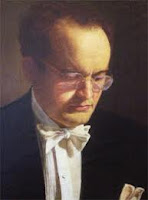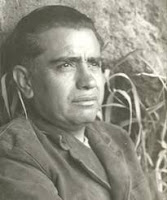 |
| Rivera, Mercado de flores |
OK, let's breeze at a leisurely pace through a few more fascinating Mexican composers.
Luis Sandi (1905-1996), studied with Carlos Chávez There's not much to go on, but what little music I've been able to access suggests that he was a fine mainstream Mexican composer. The third movement of his La Hoja de Plata, for example, begins as a rhythmically-driven, tuneful piece of Mexicana before it abruptly veers into something far more dissonant. (It may be a sign of watching too much news but the rhythm of this central section sounds like Allahu Akbar to me!) The invasion of modernist dissonance soon passes and the tuneful, popular-style music of the opening dances back in. The tempting Scherzino from his Third Symphony may use percussion and has a strong rhythmic element but the themes sound more international than Mexican. Given the quality of that short movement, this is a symphony I'd love to hear in full. The only other piece is a short, pleasant work for viola and piano from 1986 called Hoja de Álbum 2 which sounds like something a minor French composer from the Fauré could have written.
Miguel Bernal Jiménez (1910-1956) is an interesting, eclectic figure, a composer of Mexican nationalist religious music (nacionalismo sacro - 'sacred nationalism'). Though a friend of Ponce and Revueltas, his teachers were Italian and taught him organ, composition and Gregorian chant. Some of his pieces are openly Neo-Classical, most obviously the elegant Suite "Antigua Valladolid" for piano (where there's a minuet and a gavotte), though the harmonic tartness that usually goes with Neo-Classicism is largely missing. Others combine Neo-Classical currents with shades of post-Debussyan French-style organ harmony - as in the Passacaglia and other pieces from the organ cycle Catedral. Bernal is, however, fully able to provide us with plenty of Mexican colour, as in his colourful orchestral postcards Tres Cartas de México. All the main cross-currents of his style - Gregorian chant, Mexican folk elements, Neo-Classicism, colourful orchestral scoring and organ music - come together, with Poulenc-like abandon, in his Organ Concertino of 1949. One of the composer's more charming compositions is the villancico for organ, Arrullo del Pastorcillo ('The Shepherd's Lullaby'). For a flavour of his Gregorian chant-suffused choral writing, please try the Te Deum Jubilare or his Ave Maria.
 |
| Miguel Bernal Jiménez |
Next, we come to the Grupo de los cuatro ('Group of Four'), a group of nationalist composers who sought "to use indigenous Mexican musical materials in art-music compositions", as Wikipedia puts it. (That, of course, was am aim shared by many other composers at the time.) By all accounts all four composers were taught by Carlos Chávez in a special composition class, where they consorted with some of our old friends, Reveultas and Huízar, and also got to know Copland. When political pressures forced the closure of the class the four remaining students decided to form the Grupo de los cuatro.
The oldest member of the group was Daniel Ayala (1906-1975), a composer of Indian extraction. Chávez wasn't his only teacher. Manuel Ponce, Candelario Huízar and Julián Carrillo all had a hand in teaching him to compose. However, Chávez is the teacher who matters if Ayala's most famous work is anything to go by. Tribu ('Tribe') consists of three sections evoking ancient Mayan scenes - On the Plain, The Black Snake and Dance of Fire. The titles show the Chávez 'Aztec' agenda of using Indian melodies and plenty of percussion. It dates from 1934 - that is, before Sinfonia India, which is interesting. It is a highly enjoyable piece and brilliantly orchestrated. What else did he write? Where did he go from there?
Salvador Contreras (1910–1982) also had Huízar as a composition teacher as well as Chávez. I have only two works for you - which is one more than I had for Ayala, except that I only have extracts! The first is a brief glimpse of his choral piece Corridos which confirms that he was a nationalist composer at one strange. However, all I substantially have for you are the final two movements of his Fourth String Quartet of 1966. I could say that the slow movement sometimes uses Revueltas-style ostinati to accompany its sombre melodies but that would be clutching at straws for - like Revueltas in his quartets (he says, keeping at it!) - the music ploughs a firmly international path. There is something of the Shostakovich of the string quartets about it, though it has travelled further down the atonal road than Shostakovich ever went. Serialism clearly impacted on Contreras (as it did on Copland), though the music still shows its tonal roots. I like this sort of music and would love to hear the full piece. Maybe someone can perform it alongside a Shostakovich quartet, so as to get the punters in!
 |
| Rivera, Muchacha con girasoles |
The third member of the Group of Four is a more familiar name to me, Blas Galindo (1910-1993), another composer of Indian extraction. I know him through the Sones de Mariachi, an undemanding work that does get occasional airings in Britain. Mariachi, as you probably know, is Mexico's best-known kind of folk music - one that drew in elements of popular music as it developed. The score comes from 1940 and presents three tunes. It is well-scored and full of enticing cross-rhythms. Galando was taught by another old friend, José Rolón, as well as by Copland and Chávez. Some of Rolón's Neo-Classicism may have rubbed off on Galindo if his Homenaje a Cervantes of 1947 is anything to go by. The Baroque-style movement titles Gavota/Museta, Sarabanda and Giga give that game away. The orchestration remains colourful however. Like Sones de Mariachi, Homenaje de Cervantes makes for pleasant listening without touches any depths. (Not all music needs to touch any depths of course). A different, deeper side to Blas Galindo can be heard in a lovely accompanied choral piece, En noche entristecida ('In saddened night'), which has some interesting harmonies and a beautiful solo soprano part. This piece needs airings in Britain, maybe courtesy of the BBC Singers. Another chorus you (and they) might like to try is La Montaña, which has some intriguing chromatic writing. And, as good things are said to come in threes, I suspect you'll find the calming Me gustas cuando callas a winning piece too. (The title has nothing to do with liking Maria Callas). All three choruses are tonal and international in style. The Neo-Classicist resurfaces in the beautiful Siete Piezas for Piano from 1952, now tinged (as come to think of it were the choruses) with a touch of Ravelian harmony. These are also pieces that would have a wide appeal if pianists took them up. The remaining Mexicana elements in these pieces are faint scents rather than strong perfumes. Like Contreras, he seems to have moved away from the Mexican musical nationalist agenda as time passed. As did Mexico, by all accounts, following the death of my next composer...
The best-known member of the Grupo de los cuatro, however, was José Pablo Moncayo (1912-1958) - another Huízar and Chávez pupil . Many people know (and love) his 1941 Huapango. When I was much younger I would imagine film scenarios to it where I would ride into a Mexican village to save it from Eli Wallach, cheered on by children, and then ride off to the big tune with the loveliest señorita. Yes, it's either that sort of piece or else I was that sort of young man! Huapango uses three very catchy folksongs (el siquisirií, el balajú and el gavilán) and Moncayo scored them to bring out the folk colouring - the trumpets, for example and the call-and-response effects - and add extra percussion and an attractive part for harp. The huapango itself is a dance that combines 2/4, 3/4, and 6/8 time. What results are cross-rhythms. Huapango remains a delightful, uplifting piece. I've pressed the replay button three times tonight already.
 |
| José Pablo Moncayo |
Now, what else did Moncayo write? Well, there's a symphonic poem called Tierra de Temporal (1949) for starters (does this translate as 'Land of Time'?) This does seem to me to be a masterpiece and I would place it as one of my main discoveries on this journey. In the phrase 'symphonic poem' I would place emphasis on both words. Moncayo does place some Mexican folk melodies at the heart of the piece but they are threads woven into a tapestry of the greatest beauty. There is a definite flavour of Aaron Copland in this piece - the Copland of slow movements - and I reckon the American would have felt proud to have penned something so radiant as this gentle, glowing orchestral score.
Huapango has been such a hit that it has obscured everything else by this composer. The more I hear the sadder this becomes. Another symphonic poem, Bosques ('Forests') from 1954, is almost in the same league as Tierra de Tempora. Again, the Aaron Copland-like feel of the music is plain to hear but with it go some native Indian-inspired passages. Moving to the early stage of his career, Impressionist underpinnings are heard to good effect in Amatzinac, for solo flute and string quartet (or string orchestra), where the flute plays modal melodies against a quiet and mysterious backdrop of strings before the piece erupts in an energetic Indian dance. Ostinatos underpin the slow dance that follows before another fast dance bursts out. The music, however, ends mysteriously. Amatzinac (named after a river in Mexico) is another cracking piece. The Chávez-inspired Indian side of Moncaya's pieces can also be heard in the attractive short opera La mulata de Córdoba (1948), based on an old Mexican folktale about an unaging black enchantress who vanishes in a cloud of fire just before the Inquisition can execute her. I'm also very taken by the Sinfonietta (1945).
For a taste of what Moncayo sounds like without orchestral clothes, please try his likable Viola Sonata (1934) and Muros verdes for piano (1951).
The death of
José Pablo Moncayo in 1958 is thought to be one of the most significant landmarks on our journey through Mexican musical history as it is said to mark the end of the nationalist school in Mexico. What came next?
Hi! I'm Mexican and I enjoyed your entry on the Group of Four. Thank you for bringing Mexican music to a wider audience.
ReplyDeleteBy the way "Tierra de temporal" means "dry farming" with all the associated hardships of subsistence farming.
Thank you for your kind words & for translating that title. I wasn't even close with my guess!
Delete